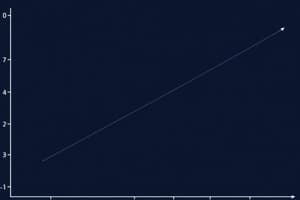Podcast
Questions and Answers
What does benchmarking software measure?
What does benchmarking software measure?
A computer's power in flops (floating point operations per second).
What is the approximate power of today's consumer computers?
What is the approximate power of today's consumer computers?
A few Gigaflops (10^6 flops)
What is the approximate power of the best current supercomputers?
What is the approximate power of the best current supercomputers?
About 1000 Teraflops (10^15 flops)
Time complexity is the evaluation of the execution time of an algorithm.
Time complexity is the evaluation of the execution time of an algorithm.
Space complexity is the evaluation of the memory space occupied by the execution of an algorithm.
Space complexity is the evaluation of the memory space occupied by the execution of an algorithm.
To save computing time, you have to use less memory space
To save computing time, you have to use less memory space
What is the complexity parameter for the factorial function?
What is the complexity parameter for the factorial function?
What is the complexity parameter for multiplying all the elements of an array of integers by a given integer?
What is the complexity parameter for multiplying all the elements of an array of integers by a given integer?
What is the complexity parameter for summing the first elements of each row in a two-dimensional table?
What is the complexity parameter for summing the first elements of each row in a two-dimensional table?
What is the constant execution time for an integer assignment?
What is the constant execution time for an integer assignment?
What is the constant execution time for an integer comparison?
What is the constant execution time for an integer comparison?
What is the constant execution time for an elementary operation on integers?
What is the constant execution time for an elementary operation on integers?
The cost of declarations, assignments and return is taken into account when calculating complexity.
The cost of declarations, assignments and return is taken into account when calculating complexity.
Complexity at worst refers to the maximum execution time for an algorithm.
Complexity at worst refers to the maximum execution time for an algorithm.
Medium complexity refers to the average execution time for an algorithm.
Medium complexity refers to the average execution time for an algorithm.
What does the O notation, also known as the Landau notation, verify?
What does the O notation, also known as the Landau notation, verify?
What does the O notation verify?
What does the O notation verify?
X = O(x^2) for x>1, since x < x^2.
X = O(x^2) for x>1, since x < x^2.
X^2 = O(x^3) for x>1, since x^2 < x^3.
X^2 = O(x^3) for x>1, since x^2 < x^3.
100*x = O(x^2) for x>100, since x < x^2
100*x = O(x^2) for x>100, since x < x^2
In(x) = O(x) for x>0, In(x)<x.
In(x) = O(x) for x>0, In(x)<x.
For i>0, x = 0(exp(x)), since for any x, x/ln(x)> i, xi < exp(x).
For i>0, x = 0(exp(x)), since for any x, x/ln(x)> i, xi < exp(x).
Ω notation: f = Ω(g) if there are constants c>0 and no such that f(x) ≤ c*g(x) for all x ≥ no.
Ω notation: f = Ω(g) if there are constants c>0 and no such that f(x) ≤ c*g(x) for all x ≥ no.
F and g being functions, f = θ(g) if there are constants c1, c2, strictly positive and no such that c1g(x) ≤ f(x) ≤ c2g(x) for all x ≥ no
F and g being functions, f = θ(g) if there are constants c1, c2, strictly positive and no such that c1g(x) ≤ f(x) ≤ c2g(x) for all x ≥ no
What is O(1) complexity?
What is O(1) complexity?
What is O(log(n)) complexity?
What is O(log(n)) complexity?
Algorithms of polynomial complexity can be used for large data sets.
Algorithms of polynomial complexity can be used for large data sets.
Exponential algorithms are usable in practice.
Exponential algorithms are usable in practice.
Moore's law states that the speed of processors doubles every 18 months.
Moore's law states that the speed of processors doubles every 18 months.
The volume of data stored in information systems is increasing linearly.
The volume of data stored in information systems is increasing linearly.
What is the complexity of the sequential search algorithm in the best case?
What is the complexity of the sequential search algorithm in the best case?
What is the complexity of the sequential search algorithm on average?
What is the complexity of the sequential search algorithm on average?
What is the complexity of the dichotomous search algorithm in the worst case?
What is the complexity of the dichotomous search algorithm in the worst case?
What is the complexity of the dichotomous search algorithm on average?
What is the complexity of the dichotomous search algorithm on average?
What is the complexity of the iterative factorial algorithm?
What is the complexity of the iterative factorial algorithm?
What is complexity parameter for the recursive factorial algorithm?
What is complexity parameter for the recursive factorial algorithm?
What is the complexity of the recursive factorial algorithm?
What is the complexity of the recursive factorial algorithm?
Derecursiving an algorithm does not change the shape of its complexity.
Derecursiving an algorithm does not change the shape of its complexity.
Moving to terminal recursion changes the shape of the complexity.
Moving to terminal recursion changes the shape of the complexity.
What is the complexity of the bubble sort algorithm in the worst case?
What is the complexity of the bubble sort algorithm in the worst case?
Selection and insertion sorts are also quadratic.
Selection and insertion sorts are also quadratic.
There are quasi-linear sorting algorithms.
There are quasi-linear sorting algorithms.
The complexity of an algorithm is the number of operations required to execute the algorithm.
The complexity of an algorithm is the number of operations required to execute the algorithm.
The complexity of a comparative sorting algorithm is based on the number of comparisons made.
The complexity of a comparative sorting algorithm is based on the number of comparisons made.
The complexity of multiplying or adding long integers is based on the number of bit operations.
The complexity of multiplying or adding long integers is based on the number of bit operations.
The complexity of multiplying two polynomials is based on summing or multiplying real numbers.
The complexity of multiplying two polynomials is based on summing or multiplying real numbers.
The number of recursive calls in a recursive function is not indicative of the time complexity.
The number of recursive calls in a recursive function is not indicative of the time complexity.
The number of assignment operations is indicative of the time complexity in algorithms that move a lot of data.
The number of assignment operations is indicative of the time complexity in algorithms that move a lot of data.
It's easy to identify which operations are important when studying an algorithm.
It's easy to identify which operations are important when studying an algorithm.
Flashcards
Algorithm Complexity
Algorithm Complexity
The process of understanding and predicting how long an algorithm takes to run based on the input size.
Space Complexity
Space Complexity
The assessment of how much memory an algorithm uses based on its input.
Algorithmic Complexity Analysis
Algorithmic Complexity Analysis
Estimating the time it takes for an algorithm to run by analyzing its steps and how they relate to the size of the input.
Experimental Complexity
Experimental Complexity
Signup and view all the flashcards
Benchmarking
Benchmarking
Signup and view all the flashcards
FLOPS (Floating Point Operations Per Second)
FLOPS (Floating Point Operations Per Second)
Signup and view all the flashcards
Teraflops (10^12 FLOPS)
Teraflops (10^12 FLOPS)
Signup and view all the flashcards
Gigaflops (10^9 FLOPS)
Gigaflops (10^9 FLOPS)
Signup and view all the flashcards
Temporal Complexity
Temporal Complexity
Signup and view all the flashcards
Spatial Complexity
Spatial Complexity
Signup and view all the flashcards
Variable Exchange
Variable Exchange
Signup and view all the flashcards
Big O Notation
Big O Notation
Signup and view all the flashcards
Worst-Case Complexity
Worst-Case Complexity
Signup and view all the flashcards
Average-Case Complexity
Average-Case Complexity
Signup and view all the flashcards
Best-Case Complexity
Best-Case Complexity
Signup and view all the flashcards
Linear Complexity
Linear Complexity
Signup and view all the flashcards
Exponential Complexity
Exponential Complexity
Signup and view all the flashcards
Constant Complexity
Constant Complexity
Signup and view all the flashcards
Execution Time
Execution Time
Signup and view all the flashcards
Logarithmic Complexity
Logarithmic Complexity
Signup and view all the flashcards
Study Notes
Complexity Calculations
- Algorithms are evaluated for time complexity and how long they take to run
- Comparing algorithms with the same output helps determine the best choice
- Examples of this include determining how long to calculate a factor of 100 and which sorting algorithm is best in a scenario where an item in an array was just changed
Levels of Complexity Assessment
- Algorithmic level: Analyzing and calculating complexity
- Implementation level: Testing the program experimentally
Experimental Complexity
- Evaluating program execution time experimentally
- Execution time measurements are in nanoseconds
- Different algorithms' execution times are shown in a chart
- Factors like programming language, computer, and operating system influence experimental evaluation
Benchmarking
- Software for measuring computer power in floating-point operations per second (flops)
- Power varies depending on the tasks (calculations, integers, reals, displays)
- Modern computers measure in Gigaflops (10^6) and supercomputers in Teraflops (10^12) (www.top500.org)
Temporal vs. Spatial Complexity
- Example: Swapping two integer values efficiently using two variables and operations
- Time complexity: measuring execution time
- Spatial complexity: evaluating memory usage
Complexity Parameter
- Example: Calculating factorial of 'n' using a function
- Complexity parameter is 'n' value
- Example: Multiplying array elements by a constant value
Complexity Classes
- O(1): Constant time; execution time is not affected by input size
- O(log n): Logarithmic time; execution time grows slowly with input size
- O(n): Linear time; execution time grows proportionally to input size
- O(n log n): Quasi-linear time; execution time grows slightly faster than linear
- O(n2): Quadratic time; execution time increases significantly with input size
- O(ni): Polynomial time; execution time is influenced by parameters
- O(2n): Exponential time; execution time increases dramatically with input
Studying That Suits You
Use AI to generate personalized quizzes and flashcards to suit your learning preferences.




